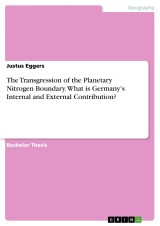Details

The Transgression of the Planetary Nitrogen Boundary. What is Germany's Internal and External Contribution?
1. Auflage
|
15,99 € |
|
| Verlag: | Grin Verlag |
| Format: | |
| Veröffentl.: | 19.02.2020 |
| ISBN/EAN: | 9783346116994 |
| Sprache: | englisch |
| Anzahl Seiten: | 38 |
Dieses eBook erhalten Sie ohne Kopierschutz.
Beschreibungen
Bachelor Thesis from the year 2016 in the subject Geography / Earth Science - Cartography, Geographic Information Science and Geodesy, grade: 1,7, Humboldt-University of Berlin (Potsdam-Institut für Klimafolgenforschung), language: English, abstract: This work tries to answer the question of Germany’s contribution to agricultural sources, through the total consumption of products and services. An environmentally-extended multi-regional input-output (“MRIO”) analysis is applied to track and account, direct and indirect, N-fertilizer use through international supply chains in 2007.
From the resulting 31 kg N/cap consumption based N-fertilizer use, 60% are embodied in imports and 40 % used internally. Comparing consumption based and production based val-ues shows, that Germany is a net-importing country of embodied N-fertilizer use with + 9 kg N/cap. The total amount of N-fertilizer used for domestic production, imports and exports is 41 kg N/cap. Due to low long-term storage of Nr in the agricultural system, Nr sources cor-respond approximately to Nr losses (Rockström et al. 2009, Bodirsky et al. 2014) that can cause (multiple; but not linearly-dependent) environmental impacts (Galloway et al. 2003, Bodirsky et al. 2014). Complexities from the nitrogen cascade (Galloway et al. 2008) and social-economic dynamics puts also locally manifested N- boundary processes on a global scale (Häyhä et al. 2014, 7), challenging (consumption based) national bottom up boundaries in view of external N-flows. A “footprint”/boundary perspective that compares current na-tional consumption based shoe sizes, per capita, with an equal, per capita, share of the PB N could provide a relevant estimation of the needed reductions to return to the safe operating space. For Germany a transgression of 270-310%, of which approximately two thirds is ex-ternal, and one third internal Nr from human intended fixation processes, is found.
It can be concluded that German consumption drives substantial local nitrogen pollution in other countries and mitigation, especially through sufficiency approaches, is necessary to return to the safe operating space.
From the resulting 31 kg N/cap consumption based N-fertilizer use, 60% are embodied in imports and 40 % used internally. Comparing consumption based and production based val-ues shows, that Germany is a net-importing country of embodied N-fertilizer use with + 9 kg N/cap. The total amount of N-fertilizer used for domestic production, imports and exports is 41 kg N/cap. Due to low long-term storage of Nr in the agricultural system, Nr sources cor-respond approximately to Nr losses (Rockström et al. 2009, Bodirsky et al. 2014) that can cause (multiple; but not linearly-dependent) environmental impacts (Galloway et al. 2003, Bodirsky et al. 2014). Complexities from the nitrogen cascade (Galloway et al. 2008) and social-economic dynamics puts also locally manifested N- boundary processes on a global scale (Häyhä et al. 2014, 7), challenging (consumption based) national bottom up boundaries in view of external N-flows. A “footprint”/boundary perspective that compares current na-tional consumption based shoe sizes, per capita, with an equal, per capita, share of the PB N could provide a relevant estimation of the needed reductions to return to the safe operating space. For Germany a transgression of 270-310%, of which approximately two thirds is ex-ternal, and one third internal Nr from human intended fixation processes, is found.
It can be concluded that German consumption drives substantial local nitrogen pollution in other countries and mitigation, especially through sufficiency approaches, is necessary to return to the safe operating space.

















